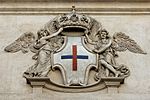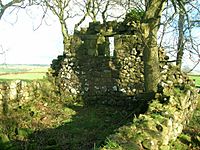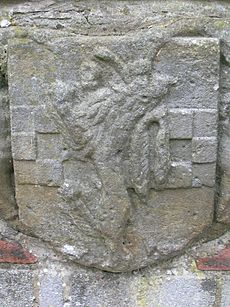Barnweill Church facts for kids
Quick facts for kids Barnweill Church |
|
|---|---|

Barnweill Parish Church (suppressed 1673)
|
|
| Location | Craigie, South Ayrshire |
| Country | |
| Denomination | Protestant |
| History | |
| Former name(s) | 'Kirk in the Wood' |
| Status | Incumbent driven out in 1689 |
| Dedication | Originally to the Holy Rood |
| Events | Significant links with John Knox |
| Architecture | |
| Functional status | Cemetery in use until 1963 |
| Heritage designation | Category B listed |
| Closed | 1689 |
| Specifications | |
| Materials | Dressed stone and rubble |
| Administration | |
| Parish | Barnweil until 1673, then Craigie |
Barnweill Church is an old ruined church in South Ayrshire, Scotland. It sits on a hill near the village of Craigie, not far from Tarbolton. People used to call it the "Kirk in the Wood" because it was surrounded by trees. This church is famous because of its connection to John Knox, a very important person in the Protestant Reformation in Scotland.
Contents
Discovering Barnweill Church's Past
What's in a Name?
The name "Barnweill" has been around for a long time. It was first written down as Berenbouell around the late 1100s. Some people think the name comes from an old word meaning 'tree'.
There's also a local story about how the name came to be. It's said that after William Wallace burned down some barns in Ayr, people said, "The barns burn weil" (meaning "well"). This story might be where the name "Barnweill" comes from.
Links to Fail Monastery
The land and church of Barnweill belonged to Fail Monastery until the Reformation in 1563. Fail Monastery was run by the Trinitarians. These monks were also known as the 'Red Friars'. Their special job was to help free people who had been captured and made into slaves.
The Parish of Barnweill
A "parish" is like a church district. The Parish of Barnweill was officially closed down in 1673. Most of its money and duties were given to the minister of the new Parish of Stair. The nearby area of Craigie also received some of Barnweill's land.
It's said that the Earl of Stair wanted the parish closed. He found it too difficult to ride his horse all the way to Barnweill Church from his home. Many people in the parish were not happy about this change. It took until 1707 for the old parish to be fully joined with Craigie and Tarbolton.
Even today, the churches of Symington and Craigie still gather at Barnweill Church. They meet there every Easter at sunrise to celebrate the Resurrection.
People of the Church
Over the years, many different people worked at Barnweill Church.
- In the early 1600s, Robert Cunningham was the minister.
- Later, Alexander Henderson was recorded as the minister in 1637.
- During a difficult time in Scotland (the 'Killing Times'), Barnweill was one of the few churches that easily accepted the new church rules. The minister then was Mr Robert Wallace.
- The last minister of Barnweill was the Rev Robert Kincaid. He was forced to leave the church in 1689.
People called "readers" also helped at the church. Robert Gaw was a reader in 1574, and David Allanson was a reader from 1576 to 1580. Sir John Miller, who used to be a chaplain, became an "exhorter" at Barnweill in 1561. The Wallace family of Craigie Castle held the job of parish clerk. This person helped keep the church clean and tidy.
The Church Building
The church building itself is now a small ruin. It is about 13.7 meters long and 5.7 meters wide. The walls are about 0.75 meters thick and stand about 1.5 meters high. This old church was likely built around the early 1400s. After the parish was closed in 1673, the church slowly fell into ruins.
The building had doors on both the north and south sides. There is a rounded window in the east wall, which suggests it was built in the 1400s. The stronger west wall might also be from medieval times. Records from 1857 show that the ivy-covered walls were still tall, but the side walls were already very low. You can see signs of recent repairs to keep the ruins from falling apart more.
The church bell was still there in the early 1800s. It was later given to a chapel in Ayr in 1857.
The Cemetery
The church sits within a square cemetery surrounded by trees. The oldest readable gravestone is from 1661, but some look even older. A very old path leads to the church from a nearby road. This path was used for funerals and by people coming to church. The last known burial in the cemetery was in 1963.
Some gravestones have special designs, like a raised shield or a lion. The lion is the symbol of the Wallace family from Craigie Castle. Many different family names are on the gravestones, including Neil, Brown, Glover, Anderson, and Fraser.
One interesting gravestone is for Col J W Neil Smith. It also mentions his wife, Evelyn Mary Mapis Duke, who passed away in 1940. Another curious stone is a small, fallen one from 1911 that says 'Our Dear Frau'. This might be for a family pet.
John Knox and the Reformation
John Knox is said to have preached at Barnweill Church. It is believed that this church was where he first began the Scottish Reformation in the Ayrshire area. This makes Barnweill Church a very important place in Scottish history.
Interesting Facts
- It was common in Ayrshire for churches to be built close to fortified houses or castles.
- The village of Barnweill no longer exists. However, old maps show that there were once houses called Townhead, Midtown, and Townend of Barnweill along the local road.
- During the time of Queen Anne (early 1700s), some people from the old Barnweill Parish were accused of setting fire to the new church in Stair.
- A woman from the old Parish of Barnweill was accused of being a witch and was executed in Ayr in 1586 or 1587.
- The land of Barnweill was once owned by the Hamilton and Wallace families.
- Underwood House, a nearby building, was once known as Nether Barnweill.
See also





